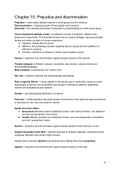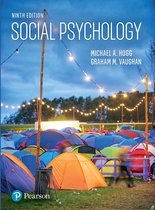Chapter 10: Prejudice and discrimination
Prejudice = unfavorable attitude towards a social group and its members.
Dehumanization = stripping people of their dignity and humanity.
Genocide = the ultimate expression of prejudice by exterminating an entire social group.
Three-component attitude model = an attitude consists of cognitive, affective and
behavioral components. This threefold division has an ancient heritage, stressing thought,
feeling and action as basic to human experience.
1. Cognitive, beliefs about a group
2. Affective, strong feelings (usually negative) about a group and the qualities it is
believed to possess
3. Conative, intentions to behave in certain ways towards a group
Sexism = prejudice and discrimination against people based on their gender .
Female subtypes in Western cultures: housewife, sexy woman, career woman and
feminist/athlete/lesbian.
Male subtypes: businessman and ‘macho man’
Sex role = behavior deemed sex-stereotypically appropriate.
Role congruity theory = mainly applied to the gender gap in leadership, because social
stereotypes of women are inconsistent with people’s schemas of effective leadership,
women are evaluated as poor leaders.
Gender = sex-stereotypical attributes of a person.
Face-ism = media depiction that gives greater prominence to the head and less prominence
to the body for men, but vice versa for women.
Sexist men have either:
1. benevolent attitudes towards traditional women, who need protection, are attractive
and who accept gender role division.
2. hostile attitudes towards non-traditional women, who are independent, competitive
and don’t accept their ‘place’.
Racism = prejudice and discrimination against people based on their ethnicity or race.
Implicit association test (IAT) = reaction-time test to measure attitudes, particularly those
unpopular attitudes that people might conceal.
People start to become abstract and general when talking about their prejudices.
Ageism = prejudice and discrimination against people based on their age.
47





